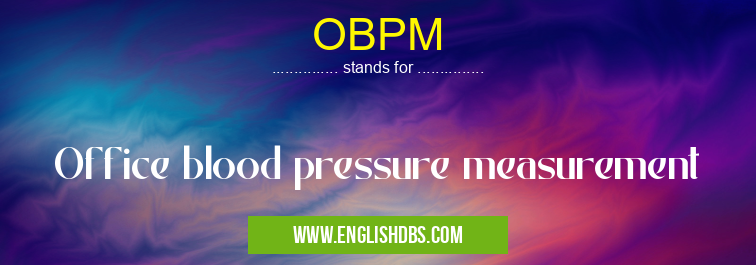What does OBPM mean in MEDICAL
OBPM (Office Blood Pressure Measurement) is a crucial aspect of healthcare that provides important insights into an individual's cardiovascular health. It involves measuring the force exerted by blood against the walls of arteries during two phases of the cardiac cycle: systole (contraction) and diastole (relaxation). OBPM is essential for:

OBPM meaning in Medical in Medical
OBPM mostly used in an acronym Medical in Category Medical that means Office blood pressure measurement
Shorthand: OBPM,
Full Form: Office blood pressure measurement
For more information of "Office blood pressure measurement", see the section below.
- Screening: Identifying individuals at risk for hypertension or cardiovascular disease
- Diagnosis: Confirming the presence of hypertension
- Monitoring: Tracking blood pressure over time and evaluating the effectiveness of treatment
Understanding OBPM
The standard procedure for OBPM involves:
- Using a calibrated sphygmomanometer
- Inflating the blood pressure cuff to a specific pressure
- Gradually deflating the cuff while listening for Korotkoff sounds (sounds created by blood flow) through a stethoscope
- Recording the first (systolic) and last (diastolic) Korotkoff sounds in mmHg (millimeters of mercury)
OHBP vs. HBPM
OBPM differs from home blood pressure monitoring (HBPM), which is done by individuals themselves using specific devices. While HBPM can provide valuable information, it is important to note that OBPM:
- Is typically more accurate due to standardized procedures and trained professionals
- Is essential for initial diagnosis and monitoring of hypertension
- Provides additional clinical context and physical examination findings
Essential Questions and Answers on Office blood pressure measurement in "MEDICAL»MEDICAL"
What is OBPM?
Office blood pressure measurement (OBPM) is a method of measuring blood pressure in a clinical setting, typically by a healthcare professional using a sphygmomanometer.
Why is OBPM important?
OBPM is important because it helps healthcare professionals diagnose and monitor hypertension, a major risk factor for cardiovascular disease. It can also provide information about a person's overall health and risk of other medical conditions.
How accurate is OBPM?
OBPM is generally considered to be accurate, but it can be affected by factors such as the person's anxiety level, the skill of the healthcare professional performing the measurement, and the type of sphygmomanometer used.
How often should I have my OBPM measured?
The frequency of OBPM measurements will vary depending on a person's age, health status, and risk of hypertension. Generally, people should have their OBPM measured at least once every two years.
What are the limitations of OBPM?
OBPM can be affected by a number of factors, such as the person's anxiety level, the skill of the healthcare professional performing the measurement, and the type of sphygmomanometer used. It is also important to note that OBPM may not always reflect a person's true blood pressure, as it can be higher than the actual blood pressure due to the "white coat effect."
Final Words: OBPM is a fundamental tool in cardiovascular health assessment. It enables healthcare professionals to screen, diagnose, and monitor blood pressure, which is crucial for managing hypertension and reducing the risk of cardiovascular events. By understanding the significance and proper technique of OBPM, individuals can contribute to the early detection and effective management of their blood pressure, promoting overall well-being.
